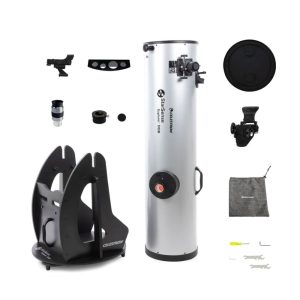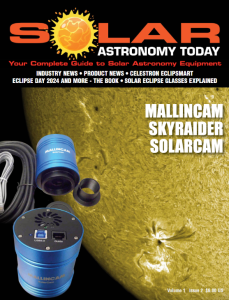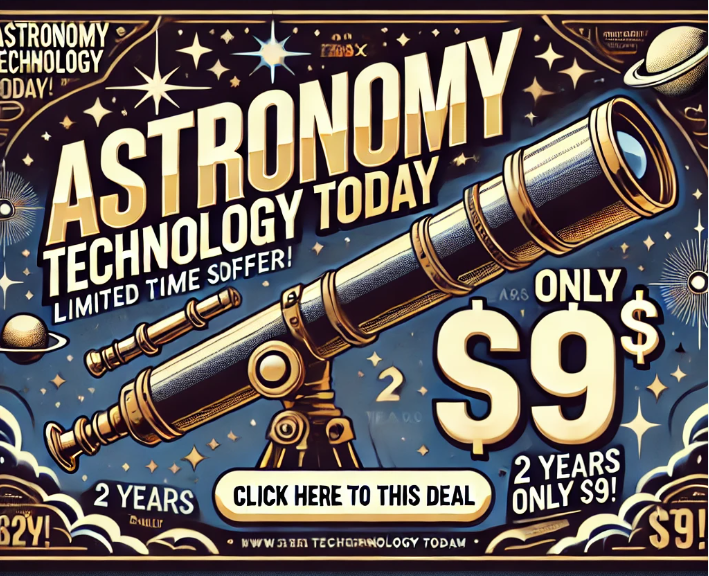Celestron is expanding their smartphone-compatible telescopes within its lineup of Celestron StarSense Explorer Dobsonians. Joining the StarSense Explorer 8” and 10” Dobsonians is a new StarSense Explorer 12″ Dobsonian.
 With a large 12″ Newtonian reflector optical tube, this telescope has enough light-gathering ability to bring out impressive detail in celestial objects. You can expect sharp, bright views of Jupiter’s four Galilean moons, its cloud bands and Great Red Spot, the rings of Saturn, the gaseous glow of the Orion Nebula, dust lanes in the Lagoon Nebula, and our neighbor galaxy, Andromeda. Compared to the other StarSense Explorer Dobsonian telescopes, the 12” Dobsonian has significantly more light gathering ability than the 8” and 10” models, providing better views of faint objects, yet still offered at an affordable price.
With a large 12″ Newtonian reflector optical tube, this telescope has enough light-gathering ability to bring out impressive detail in celestial objects. You can expect sharp, bright views of Jupiter’s four Galilean moons, its cloud bands and Great Red Spot, the rings of Saturn, the gaseous glow of the Orion Nebula, dust lanes in the Lagoon Nebula, and our neighbor galaxy, Andromeda. Compared to the other StarSense Explorer Dobsonian telescopes, the 12” Dobsonian has significantly more light gathering ability than the 8” and 10” models, providing better views of faint objects, yet still offered at an affordable price.
Even if you live in a light-polluted city location, the Celestron StarSense Explorer 12” Dobsonian is advanced enough to easily pick out Jupiter, Saturn, open star clusters like the Pleiades, double stars like Alberio, the Orion Nebula, Andromeda Galaxy, and more of the best and brightest celestial objects.
But if you can take the telescope to an even slightly darker location, more objects will become visible. With this 12″ Dobsonian and relatively dark skies, hundreds of fascinating objects are well within your reach.
Thanks to the Celestron’s StarSense app’s user-friendly interface and detailed tutorials and the classic, easy-to-use classic Dobsonian OTA design, even experienced amateur astronomers will appreciate this telescope which offer satisfying aperture and fun technology that puts your smartphone to work.
The 12” StarSense Explorer Dobsonian uses patented technology and your smartphone to determine exactly where the telescope is pointed in the night sky. A Lost in Space Algorithm (LISA), like the ones satellites use in orbit to correctly orient themselves, helps the app match star patterns it detects overhead to its internal database.
 The Celestron StarSense Explorer Dobsonians telescope system uses your smartphone as a self-contained plate-solving system. Simply put, plate solving is used to determine the current pointing position by extracting star pattern data from images of the night sky. Celestron’s StarSense Explorer is the first app designed to use the power of plate solving to figure out a smartphone’s current pointing position.
The Celestron StarSense Explorer Dobsonians telescope system uses your smartphone as a self-contained plate-solving system. Simply put, plate solving is used to determine the current pointing position by extracting star pattern data from images of the night sky. Celestron’s StarSense Explorer is the first app designed to use the power of plate solving to figure out a smartphone’s current pointing position.
When coupled with the specially designed smartphone dock on a Celestron StarSense Explorer telescope, you have a manual telescope system that has the ability to capture an image of the night sky, process that image, extract the star pattern data and determine the center coordinates, all by itself, without requiring telescope alignment from the user.
The StarSense Explorer dock isn’t a normal, off the shelf smartphone holder for your telescope. It has a specially designed integrated mirror that works in conjunction with your smartphone’s camera to gather star pattern data for the StarSense Explorer app. A built-in shade keeps stray light from reflecting off the mirror and messing with the data. X-Y adjustment knobs allow the dock to hold many different smartphone sizes and oftentimes the case can be left in place.
The Celestron StarSense Explorer Dobsonian telescopes work with a wide range of smartphones, including the iPhone 6 or higher and Android 7.1.2 smartphones that were manufactured in 2016 onward and have a camera, gyro, and accelerometer sensor. You can find the app download in the Apple App Store or Google Play.
When you launch the app for the first time you’ll follow a simple two-step process that aligns your smartphone’s camera with the telescope’s field of view. Once set up, the app displays a scene of the night sky and a bullseye to show you where it is currently looking. Then it is up to you to decide what you want to look at.
 The easiest and fastest way to do that is simply to choose from the “Tonight’s Best” observing list, which is automatically generated to show you popular objects that are currently visible from your location. Depending on the time of year, your location, and the time of night, the list might include planets like Jupiter or Saturn, galaxies, nebulae, star clusters, and more.
The easiest and fastest way to do that is simply to choose from the “Tonight’s Best” observing list, which is automatically generated to show you popular objects that are currently visible from your location. Depending on the time of year, your location, and the time of night, the list might include planets like Jupiter or Saturn, galaxies, nebulae, star clusters, and more.
Equipped with XLT reflective coatings, all of the Celestron StarSense Explorer Dobsonians offer good light throughput and offer primary mirrors with low-expansion material which provides more optical path stability during fluctuating temperatures. The thin veins for the secondary mirror holder ensure there are minimal diffraction effects. Each OTA body is silver in color, matching the other StarSense Explorer series telescopes, and on the side of the optical tube, you will find a convenient carry handle for easy transport to star parties or your favorite observation spot. Celestron has included a panning knob for an ergonomic grip when pointing the telescope, preventing the introduction of heat from your hands into the optical system.
The StarSense Explorer 12″ Dobsonian offers an ultra-stable Dobsonian base which provides a sturdy foundation. It features large diameter altitude bearings with variable tensioning, Teflon azimuth bearings, and braces on the side panels for extra stability. The altitude bearings provide a smooth up-and-down motion while the integrated altitude “brake” system allows you to adjust the tension along the altitude axis for smoothest motion even with slight imbalances. The panning knob on the telescope tube provides an ergonomic grip so you can precisely point the telescope without introducing heat from your hands into the optical system. As celestial objects appear to drift across the night sky, you’ll be able to easily follow them with minor adjustments to the telescope’s position.
 The StarSense Explorer Dobsonians base includes an easy-to-grip carry handle to make travel easier. You can also remove the eyepiece rack during times of travel and then put it back once you need a handy place to put extra eyepieces during your observation sessions.
The StarSense Explorer Dobsonians base includes an easy-to-grip carry handle to make travel easier. You can also remove the eyepiece rack during times of travel and then put it back once you need a handy place to put extra eyepieces during your observation sessions.
The StarSense Explorer 12″ Dobsonian includes the StarSense Explorer dock and code card, a 32mm 1.25″ Omni Plossl eyepiece, StarPointer red dot finderscope (for initial alignment if desired or daytime use), an eyepiece rack and a collimation cap. They also come with a high-quality 2” Crayford focuser. The Crayford design provides precise and smooth movements without focus shifting. It also includes a 2” to 1.25” adapter and a 2” extension tube, so you can use virtually any 1.25” or 2” telescope eyepiece with your StarSense Explorer Dobsonian. The focuser also features a thumbscrew so you can lock in the sharpest focus.
The StarSense Explorer 12″ Dobsonian specifications include:
– Aperture: 305mm (12″)
– Focal Length: 1500mm (59″)
– Focal Ratio: f/4.9
– Focal Length of Eyepiece 1: 32mm (1.26″)
– Magnification of Eyepiece: 147x
– Highest Useful Magnification: 720x
– Lowest Useful Magnification: 43x
– Limiting Stellar Magnitude: 14.9
– Light Gathering Power: 1895x as compared to the human eye
– Optical Coatings: XLT reflective coatings with silicon dioxide and tantalum pentoxide protective overcoatings for primary and secondary mirrors
– Mirror Material: Pyrex equivalent for primary and secondary mirrors
– Primary Mirror Thickness: 37mm (1.45″) (approx. 1:8 thickness ratio)
– Secondary Mirror Thickness: 11mm (0.43″)
– Minor Axis of Secondary Mirror: 70mm (2.75″)
– Tube Material: Steel
– Focuser: 2″ Crayford focuser, includes 2″ extension tube and 2″-to-1.25″ adapter
– Finderscope: StarPointer red-dot finderscope
– Resolution Rayleigh: 0.45 arcseconds
– Resolution Dawes: 0.38 arcseconds
– Optical Tube Dimensions: 1422.4mm (56″) long x 355.6mm (14″ diameter)
– Optical Tube Weight: 49.8 lbs (22.58 kg)
– Mount Type: Altazimuth Dobsonian base
– Mount Base Material: Particle board with melamine surfaces and edge trim, CARB compliant
– Mount Base Dimensions: 635mm x 635mm x 736.6mm (25″ x 25″ x 29″)
– Mount Base Weight: 33.8 lbs (15.33 kg)
– Slew Speeds: Manual
– Software: Celestron Starry Night Basic Edition Software and StarSense Explorer App
– Total Telescope Kit Weight: 83.6 lbs (37.92 kg)
You can learn more about the Celestron StarSense Explorer Dobsonians at here.

 And to make it easier for you to get the most extensive news, articles and reviews that are only available in the magazine pages of Astronomy Technology Today, we are offering a 1-year magazine subscription for only $6! Or, for an even better deal, we are offering 2 years for only $9. Click here to get these deals which only will be available for a very limited time. You can also check out a free sample issue here.
And to make it easier for you to get the most extensive news, articles and reviews that are only available in the magazine pages of Astronomy Technology Today, we are offering a 1-year magazine subscription for only $6! Or, for an even better deal, we are offering 2 years for only $9. Click here to get these deals which only will be available for a very limited time. You can also check out a free sample issue here.
The Sun is more active than it’s been in years and if that’s not enough, we have the Annular Solar Eclipse on October 14, 2023 and the Total Solar Eclipse on April 8, 2024! If you’d like to learn more about the technology behind solar observing, solar imaging and more, you can check out our new monthly magazine – Solar Astronomy Today. It’s free to read, no subscription needed and available here. And if you are preparing for the upcoming eclipses and want to know your equipment options from solar glasses to the most out of this world solar viewing and imaging options, check out our free publication – The Definitive Guide to Viewing and Imaging the Sun – simply click here and enjoy reading!



